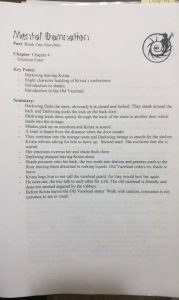
Want to Write a Fiction Novel? Part 3 – Chapter Outlines
Estimated Reading Time:
Welcome to the final part of the 3 part miniseries titled Want to Write a Fiction Novel? In the first post, we looked at creating the premise for your novel, thinking from a 5,000 foot view. In the second part we discussed plot outlines, looking at the general direction of the plot on a single page. With each post, we dig a bit deeper into the story, each component complimenting the previous. This post, we will look at developing each chapter outline found within the plot. These chapters reflect the important points we made on our plot outline.
What is a Chapter Outline?
A chapter outline differs from the plot outline, which offered a visual representation of the rise and fall of the story. The chapter outline level of planning is more linear and is intended to point out all major events that happen in the chapter. It is also the last phase of planning before jumping into the writing itself, with the exception of character sheets. These are done before, during and after the plot planning.
Each person has their own process with character sheets. You can find some insight into them from the “Defining a Character” series that I had written previously.
What is included in a Chapter Outline?
Good question, chapter outlines should be about a single page, labeled numerically. Each outline should include four key sections:
- Objectives
- Characters
- Point of View
- Summary
Objectives
The objectives section is the most important part on the page. This states the primary focus of the chapter that moves the story forward. Ask yourself if the chapter is developing a character or moving the plot onward. If it is not, what is it doing in the book?
Characters
This is a reference check, exceptionally helpful if your plot has a lot of characters. You’ll want to note who appears in a chapter in case you need to recall when and where they last appeared in the plot. It helps avoid major plot holes by knowing where your characters are.
Point of View
This section may or may not be used, depending on the type of story you are writing. If your plot has multiple narrators, then you will want to make note on whose perspective the story is being told through.
Summary
The guts of the chapter outline, here you will write down each event that happens in this section of the story based on the objectives you previously stated. Noticing a pattern here? Your chapter outlines are like mini premises and plots.
Your Objectives are much like the premise and the Summary is like your plot outline on a smaller scale.
That’s great, so how do I start a chapter outline?
Time to pull out your premise and your plot outline that you made earlier! Take a hard look at them by asking yourself questions about each of the points you made on the plot outline. What are the details of each event? How do they connect from one to the other? Broaden on the protagonist’s and antagonist’s goals. You answer all these questions by jotting them down on chapter outlines.
You do not have to start in a linear fashion.
If you want to work backwards, go right ahead. Sometimes the plot is a story where you need to figure out the details of the ending first, then you can visit the beginning. Some plots might not have the ending flushed out and you won’t know until you figure out the rest of the story first. In this case you will probably start with chapter 1’s outline.
This is your book, write it in any order you want. Trust your intuition.
Example of a Chapter Outline
In the photo below (click to enlarge), you can see a printed off chapter outline for the original Chapter 4 – Emotion Eater found in Mental Damnation: Reality. This is an extremely simplified version of a chapter outline. This worked because the chapter itself was short and had only a few key objectives.

Your Exercise
Now that we’ve covered how a chapter outline works, use the template below for your chapter outlines. Copy this into any editor you prefer or print it off:
Chapter title:
Objectives:
–
–
–
Characters:
–
–
Point of View:
Summary:
–
–
–
–
This sums up the 3 part series of writing a novel. There are MANY more topics to cover with writing a book that cannot be covered in 3 blog posts. I hope this does offer some structured direction for writing your novel.
If you have any additional knowledge to how you prefer to plan out a novel, please share in the comments.

About Konn Lavery
Konn Lavery is a Canadian author whose work has been recognized by Edmonton’s top five bestseller charts and by reviewers such as Readers’ Favorite, and Literary Titan.




